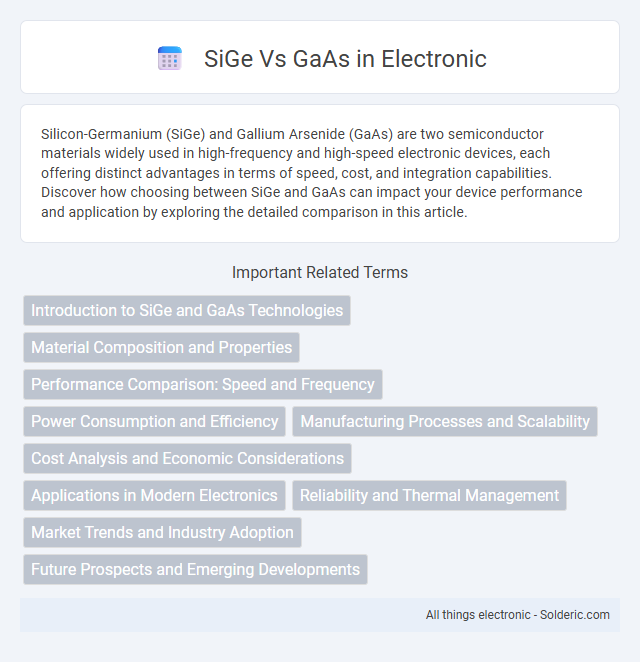Silicon-Germanium (SiGe) and Gallium Arsenide (GaAs) are two semiconductor materials widely used in high-frequency and high-speed electronic devices, each offering distinct advantages in terms of speed, cost, and integration capabilities. Discover how choosing between SiGe and GaAs can impact your device performance and application by exploring the detailed comparison in this article.
Comparison Table
| Feature | SiGe (Silicon-Germanium) | GaAs (Gallium Arsenide) |
|---|---|---|
| Material Type | Silicon-Germanium alloy | Compound semiconductor |
| Electron Mobility | Moderate (Higher than pure silicon) | High (3-5 times silicon) |
| Frequency Performance | Up to 300 GHz | Typically >300 GHz |
| Power Efficiency | Moderate | High |
| Cost | Lower (Compatible with silicon processes) | Higher (Expensive substrates and process) |
| Integration | High (CMOS compatible) | Limited (Heterogeneous integration) |
| Thermal Conductivity | Good (Silicon-based) | Poor (Lower thermal conductivity) |
| Applications | High-speed digital, RF ICs, low-cost analog | High-frequency RF, microwave communications, optoelectronics |
Introduction to SiGe and GaAs Technologies
SiGe (Silicon-Germanium) technology integrates germanium into silicon substrates, enhancing transistor speed and frequency response while maintaining cost-effective silicon manufacturing processes. GaAs (Gallium Arsenide) technology offers superior electron mobility and high-frequency performance, making it ideal for microwave and RF applications despite higher production costs. Both SiGe and GaAs are essential in high-speed communication systems, with SiGe favored for integration with silicon CMOS and GaAs for high-power, high-frequency devices.
Material Composition and Properties
Silicon-Germanium (SiGe) semiconductors are composed of a silicon base alloyed with germanium, offering enhanced electron mobility and compatibility with existing silicon fabrication technology. Gallium Arsenide (GaAs) consists of gallium and arsenic atoms forming a compound semiconductor known for its high electron mobility and direct bandgap, which enables superior high-frequency performance and optoelectronic applications. SiGe provides improved integration with silicon circuits and lower production costs, while GaAs excels in high-speed and high-frequency applications due to its unique crystal structure and electronic properties.
Performance Comparison: Speed and Frequency
SiGe technology excels in high-frequency applications with operational speeds typically reaching up to 300 GHz, making it suitable for fast analog and RF circuits. GaAs devices outperform SiGe in ultra-high-frequency domains, often exceeding 600 GHz, enabling superior performance in microwave and millimeter-wave systems. Your choice depends on whether speed and frequency requirements prioritize wideband microwave applications (favoring GaAs) or cost-effective, high-speed integration with silicon compatibility (favoring SiGe).
Power Consumption and Efficiency
SiGe technology exhibits lower power consumption due to its compatibility with silicon-based CMOS processes, enabling efficient integration and reduced leakage currents. GaAs devices offer superior efficiency at high frequencies and power densities, providing excellent performance in RF and microwave applications. The overall power efficiency of SiGe is favorable for low-to-mid frequency circuits, whereas GaAs remains optimal for high-frequency applications demanding maximum power output.
Manufacturing Processes and Scalability
SiGe manufacturing leverages mature silicon foundry infrastructure, enabling cost-effective scalability and integration with CMOS technology. In contrast, GaAs fabrication involves more complex and expensive processes, such as epitaxial growth on native substrates, limiting large-scale production. Your choice between SiGe and GaAs depends on prioritizing scalable manufacturing and system integration versus higher-frequency performance.
Cost Analysis and Economic Considerations
SiGe technology generally offers lower manufacturing costs compared to GaAs due to its compatibility with standard silicon fabrication processes and higher wafer yields. GaAs devices, while delivering superior high-frequency performance, involve more expensive substrates and complex production steps, increasing overall expenses. Evaluating your project's budget against performance needs will guide the optimal choice between cost-effective SiGe and premium GaAs solutions.
Applications in Modern Electronics
SiGe technology excels in high-speed analog and RF applications such as wireless communication systems, automotive radar, and low-noise amplifiers due to its compatibility with CMOS processes and cost-effectiveness. GaAs is preferred in high-frequency and high-power applications including satellite communication, microwave and millimeter-wave radar systems, and optoelectronic devices because of its superior electron mobility and thermal performance. Both materials play critical roles in modern electronics, with SiGe dominating integrated circuits and GaAs leading in specialized RF and optoelectronic components.
Reliability and Thermal Management
Silicon-Germanium (SiGe) offers superior reliability compared to Gallium Arsenide (GaAs) due to its robust thermal stability and well-established manufacturing processes, which reduce device degradation over time. SiGe devices exhibit better thermal management capabilities, efficiently dissipating heat under high-power and high-frequency operations, thus minimizing performance loss and extending operational lifespan. GaAs, while offering high electron mobility, suffers from lower thermal conductivity, making it more susceptible to heat-induced reliability issues in demanding environments.
Market Trends and Industry Adoption
SiGe technology is rapidly gaining traction in high-frequency and high-speed applications due to its excellent integration capabilities and cost-effective manufacturing, particularly in automotive radar and 5G infrastructure markets. GaAs remains dominant in applications requiring superior electron mobility and high power density, such as satellite communications and defense radar systems, benefiting from its mature fabrication ecosystem. Market adoption trends indicate that SiGe is expanding in consumer electronics and telecommunications, while GaAs continues to hold a strong position in specialized high-performance RF and microwave segments.
Future Prospects and Emerging Developments
SiGe technology is rapidly advancing with improvements in integration capabilities and cost-effectiveness, making it a strong contender for future high-frequency and low-power applications, particularly in 5G and IoT devices. GaAs continues to excel in high-frequency and high-power domains, benefiting from innovations in epitaxial growth and novel device architectures that enhance performance in radar and satellite communications. Your choice between SiGe and GaAs should consider ongoing developments, as SiGe's scalability and GaAs's superior electron mobility drive emerging applications in wireless infrastructure and next-generation electronics.
SiGe vs GaAs Infographic

 solderic.com
solderic.com